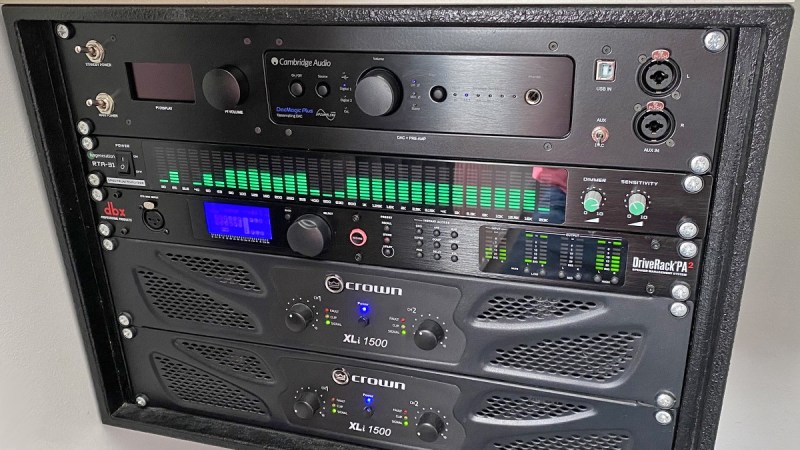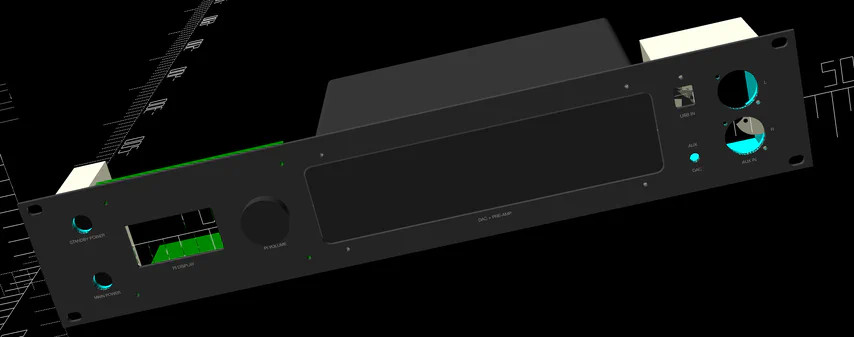For those who love systems and structure, owning a 19-inch rack with just one slot filled is just not it. But what if the rest of your gear isn’t 19-inch? Well, then you go out and make it so, just like [Cal Bryant] did recently.
The goal was to consolidate multiple devices — DAC, input selector, streamer, and power routing — into a single 2U rackmount unit. His first attempts involved drilling 1U panels to attach gear with removable faceplates. That worked, but not all devices played nice. So his next step became a fully custom enclosure with CAD-modeled brackets and front panels.
OpenSCAD turned out to be a lifesaver, letting [Cal] design modular mounting solutions. Exporting proper circles for CNC turret punching however appeared to be a nightmare. It was FreeCAD to the rescue for post-processing. After some sanding and auto-shop painting, the final faceplate looked factory-made.
Custom switch boxes for power and audio routing keep things tidy, housing everything from USB to XLR inputs. A 4-pole switch even allows seamless swapping between his DAC and DJ controller, while UV-printed graphics bring the finishing touch to this project. For those looking to clean up their Hi-Fi setup (or just love modding for the sake of it), there’s a lot to learn from this build.
If buying a rack is not within your budget, you could start with well-known IKEA LACK furniture.

















That is a neat solution! I hate how a lot of modern equipment comes in oddly sized plastic boxes, that are often lightweight enough so that any movement to a cable throws them off the shelf, or pulls them away from the front.
it’s even worse when they take that idea into a VST plugin with a 90s nonrectangular UI. especially when they replace linear slides with rotating knobs. do they rotate on vertical drag? horizontal drag? if you’re lucky they will rotate with the mouse wheel when hovering.
anyways back to physical devices: not only they’re all weird shapes, they’re also all sorts of funky colors and not the proper Professional Black.
I do have a MOTU unit that is 1U half-width. it looks like a standalone unit but it also can be bolted to another MOTU device to fit two in a 19 inch 1U .
Yeah, it’s a bit disappointing that MOTU designed that kit (and their half-width devices in general) so that you can ONLY use it to bolt two MOTU devices together into a full-width rackmount configuration.
(And in fact, sometimes they have to be two of the SAME MOTU device, because there’s more than one “bolt-together” kit and they’re each only compatible with certain devices. So you can’t even necessarily mix-and-match all MOTU half-width hardware into a full-width rackmount form factor.)
Basically all of their full-width hardware comes pre-configured with rack ears, ready to get slotted into a rack — but their half-width devices very much do NOT. And there is actually a standard (a de facto one, at least, if not a formalized one), so if they’d done it right their half-width devices would be installable alongside ANY other halfwidth devices from any manufacturer. As in, exactly the point of standardized rackmount configurations.
Still, I’ll concede that they’ve always been right at the forefront of hardware builders when it comes to full-width rackmount hardware, and they’re still a better-than-average equipment rack citizen overall, compared to all the companies that make no provisions whatsoever, and force people like [Cal] into creative (and time/labor-intensive) solutions like the one profiled here.
Nicely done, this turned out looking very clean!
Wow. That really whips the Llama’s arse
Beautiful!
This is a far more elegant solution than mine. I used 1u shelves and used double sided tape to keep things at the front.
Regarding the faceplate, I discovered that outside advertising boards are also a cheap option (even including brushed aluminium). That is if you can live with dibond sandwich panels. Lots of companies include cnc countouring. If you ask nicely, they also do inside holes. O.o.m. 10 Euros for 19″ front panels.
With the design you have to take into account that the print and contouring are not always perfectly aligned (in experience ca .5mm shifts possible). And typically I see they use 2mm mil, so expect rounded inside corners.